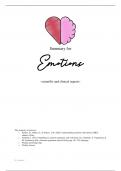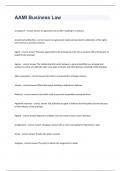Summary for
Emotions
-scientific and clinical aspects-
This summary is based on:
o Keltner, D., Oatley, K., & Jenkins, J. M. (2020). Understanding emotions (4th edition, EMEA
edition). Wiley.
o Nyklíček, I. (2011). Mindfulness, emotion regulation, and well-being. In I. Nyklíček, A. Vingerhoets &
M. Zeelenberg (Eds.), Emotion regulation and well-being (pp. 101-118). Springer.
o Weekly knowledge clips
o Weekly lectures
[1] Laura C.
, Chapter 1: Approaches to Understanding Emotions
emotion= a psychological state that relates an event, usually out there in
the world, but sometimes in the mind (the events an emotion relates to are
called concerns)
- an emotion prepares the person for action => one central component of
an emotion is an internal experience (=a state that reflects a present
context relevant to the person’s goals)
- the emotion gives priority to one goal over others; it gives that goal, or concern,
urgency (Sylvan Tomkins) => Emotions are states triggered by events related to our
concerns and that motivate action
- rather than thinking that emotions are irrational, psychologists now tend to think of
emotions as being locally rational: they help us deal adaptively with concerns specific
to our current social context (e.g., concerns over safety, fairness, agency, being
esteemed and respected, moral virtue, and feeling connected to trustworthy others)
that define our identities; emotion gives urgency to a specific concern, and orients us
to specific kinds of action.
- emotions are states that are social- they mediate, or connect, the individual’s pressing
concerns with potential courses of action within the social environment; emotions
connect our context-specific concerns with possible courses of action in the social
environment
- the interpersonal equivalent of an emotion giving priority to a concern is care; in this
context an emotion is a kind of commitment to another- we make the other’s concerns
our own
=>emotions are subjective and intrapersonal, but also powerfully social and interpersonal
Nineteenth-Century Founders
Charles Darwin: The Evolutionary Approach
Darwin asked two broad questions:
o how are emotions
expressed in humans and
other animals?
o where do our emotions
come from?
- he thought that emotional
expressions derive largely
from habits that in our
evolutionary or individual
past had once been useful;
emotional expressions are
based on reflex-like
mechanisms, and some of
them occur whether they
are useful or not; they can
[2] Laura C.
, be triggered involuntarily in circumstances analogous to those that had triggered the
original habits => our emotions link us to our past: to the past of our species and to
our own infancy
- he also observed that many emotional expressions have the same quality (many
emotions can be expressed in similar ways/ look similar) and emotions have useful
functions- they help us navigate our social interactions
- in general, emotional expression are used to communicate two things:
o that the associated emotion program has been activated in the individual (the
individual feels an emotion)
o the identity of the evolutionary recurrent situation being faced (the emotional
expression signal to those around us that something is happening)
=>some emotions have a more automatic display (sadness) but a much larger set of emotions
have no such thing (jealousy, guilt, boredom); the emotions that do not have a specific way of
expression are hypothesised to have developed later
William James: The Bodily Approach
- William James argued against the common-sense idea that when we feel an emotion it
impels us to act in a certain way (if we were to meet a bear in the woods we would
feel frightened and run); instead, James proposed that when we see the bear, “the
exciting fact” as he put it, the emotion, IS the perception of changes of our body as we
react to that fact
- James’s theorizing focuses on the nature of emotional experience- he stressed the way
in which emotions move us in bodily ways
- the core of an emotion, according to him, is the pattern of bodily responses
(=embodied nature of emotion); he said: “If we fancy some strong emotion and then
try to abstract from our consciousness of it all the feelings of its bodily symptoms, we
find we have nothing left behind”
- his idea guided the study of emotion in two important ways:
o proposed that our experience of many emotions, from fear to joy to reverence,
involves changes of the autonomic nervous system, changes of muscles and joints
and the sensory signals coming from them
o proposed that emotions give “colour and warmth” to experience; without these
effects, he said, everything would be pale
[3] Laura C.
, Sigmund Freud: The Psychoanalytic Approach
- one of Sigmund Freud’s most enduring ideas is that certain events can be so damaging
that they leave emotional scars that can affect the rest of our lives
- he was one of the first to argue that emotions are at the core of many mental illnesses
- Freud thought that an emotion in the present could derive from one in the past, in the
patient’s early life
- the method Freud developed was called psychoanalysis; characteristics of his
method:
o the telling by a patient of her or his life story, which is found to have gaps (in this
case the gap of having no idea of whose the awful face was that appeared to her in
her attacks)
o the filling of such gaps by interpretations of the therapist
o the insights of the person receiving the therapy who realizes something that had
been unconscious
- the work of Freud suggests that the emotional life of adulthood is strongly influenced
by relationships we had in childhood with parents or other caregivers- this idea was
the foundation of work of John Bowlby, a psychoanalyst who, from 1951 onward,
developed the theory of attachment
- Freud’s theories were also critical to the influential theorist Richard Lazarus who
combined them with the Darwinian evolutionary idea of adaptation, to propose that
emotions derive from how we appraise events in the environment in relation to our
goals
Philosophical and Literary Approaches
Aristotle and the Ethics of Emotions
- Aristotle offered some of the first systematic analyses of
emotions; emotions, in this view, are evaluative judgments
of events in the world; he discussed how different
judgments give rise to different emotions
- drama, said Aristotle, is about human action, and what can
happen when human actions have effects that were
unforeseen; we are humans, not gods- we simply do not
know enough to predict the consequences of everything
we do; nonetheless, this is the root of human tragedy- we
remain responsible for our actions
- Aristotle also talked about katharsis= clarification—the clearing away of obstacles to
understanding; by seeing predicaments of human action at the theatre (when we watch
a drama) we may come to experience emotions of sympathy and fear, and understand
consciously for ourselves their relation to the consequences of human action in a
world that can be known only imperfectly
- two important schools of philosophy developed out of his argument that emotions are
evaluations and depend upon one’s beliefs:
epicureanism
stoicism
- the Epicureans and Stoics are the first Western emotion researchers
[4] Laura C.





